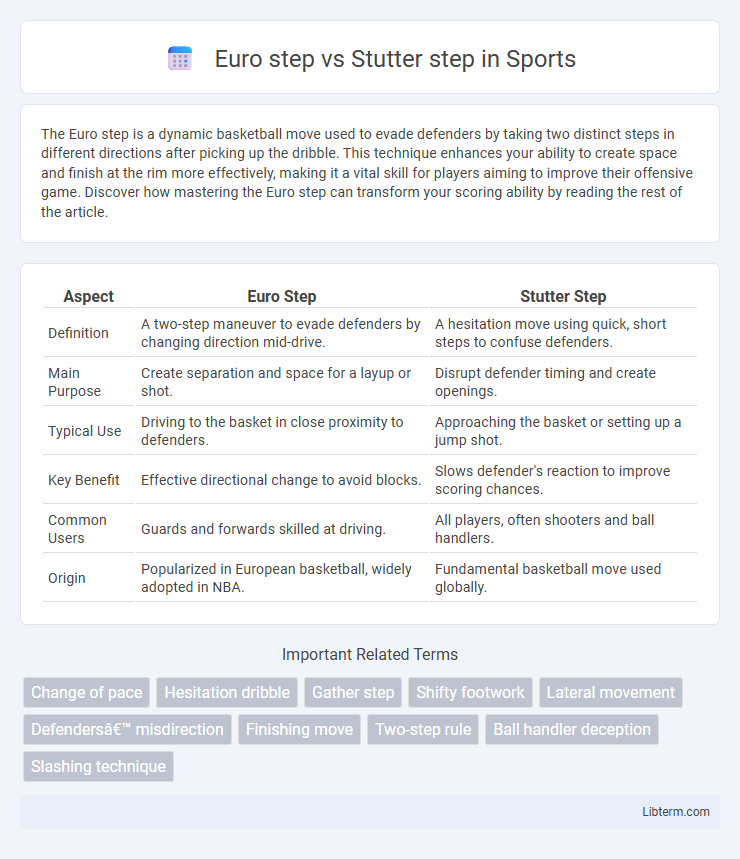The Euro step is a dynamic basketball move used to evade defenders by taking two distinct steps in different directions after picking up the dribble. This technique enhances your ability to create space and finish at the rim more effectively, making it a vital skill for players aiming to improve their offensive game. Discover how mastering the Euro step can transform your scoring ability by reading the rest of the article.
Table of Comparison
| Aspect | Euro Step | Stutter Step |
|---|---|---|
| Definition | A two-step maneuver to evade defenders by changing direction mid-drive. | A hesitation move using quick, short steps to confuse defenders. |
| Main Purpose | Create separation and space for a layup or shot. | Disrupt defender timing and create openings. |
| Typical Use | Driving to the basket in close proximity to defenders. | Approaching the basket or setting up a jump shot. |
| Key Benefit | Effective directional change to avoid blocks. | Slows defender's reaction to improve scoring chances. |
| Common Users | Guards and forwards skilled at driving. | All players, often shooters and ball handlers. |
| Origin | Popularized in European basketball, widely adopted in NBA. | Fundamental basketball move used globally. |
Introduction to Basketball Footwork Techniques
The Euro step and stutter step are essential basketball footwork techniques that enhance offensive agility and defensive maneuvering. The Euro step involves a quick, two-step maneuver to evade defenders and create scoring opportunities, leveraging lateral movement and balance. In contrast, the stutter step is a hesitation move that disrupts defenders' timing by quick, shuffling steps, allowing the player to read the defense and decide to drive or shoot.
What is the Euro Step?
The Euro Step is a dynamic basketball move where a player takes a step in one direction followed by a quick step in the opposite direction to evade defenders and create open scoring opportunities. Originating from European basketball, this technique maximizes court space and confuses defenders by breaking traditional straight-line drives to the basket. It is a highly effective move for penetrating the paint and improving finishing at the rim.
What is the Stutter Step?
The stutter step is a basketball footwork technique used to create hesitation, disrupt defenders, and gain better positioning. It involves quick, short, and rhythmic steps to stop or change pace abruptly, making it harder for opponents to anticipate the next move. This move is particularly effective in driving to the basket or setting up a shot by improving offensive timing and control.
Euro Step: Origins and Evolution
The Euro Step, a basketball move popularized by European players, originated in the early 2000s and revolutionized driving techniques by allowing players to evade defenders with a quick lateral step followed by a step in the opposite direction. This technique evolved from fundamental footwork seen in European leagues, gaining prominence in the NBA through players like Manu Ginobili, who showcased its effectiveness in high-stakes games. The Euro Step's evolution highlights its strategic value in creating space and enhancing scoring opportunities by exploiting defensive angles.
Stutter Step: Origins and History
The Stutter Step, rooted in basketball fundamentals, originated as a strategic footwork technique designed to deceive defenders and create space for a drive or shot. This move traces back to early basketball pioneers who emphasized agility and hesitation to outmaneuver opponents, evolving through decades of play. Coaches and players worldwide adopted and refined the Stutter Step, making it a critical element of offensive skill sets in modern basketball.
Key Differences: Euro Step vs Stutter Step
The Euro Step features a two-step lateral movement to evade defenders by quickly shifting direction, while the Stutter Step relies on short, quick shuffles to create hesitation and maintain balance before attacking. The Euro Step is highly effective for driving to the basket with a sudden change in trajectory, whereas the Stutter Step enhances footwork and timing for precise shot selection or passing. Euro Step emphasizes agility and deception in close-range finishes, while the Stutter Step prioritizes control and rhythm during penetration.
Situational Uses: When to Use Each Move
The Euro step is most effective in fast-break situations where defenders are spread out, allowing a player to evade a charging defender with lateral footwork. The stutter step, on the other hand, is ideal for creating hesitation in close-range defense, giving the ballhandler a moment to assess options or prepare for a quick shot or drive. Choosing between these moves depends on court spacing and defensive pressure, with the Euro step excelling in open lanes and the stutter step working best in tight, congested areas.
Advantages of the Euro Step
The Euro Step offers superior agility and deception, allowing players to evade defenders by taking a wide, lateral step before finishing at the rim, which reduces the chance of getting blocked or fouled. This move enhances efficiency in driving lanes by creating unexpected angles, resulting in higher scoring opportunities in tight traffic. Unlike the Stutter Step, which primarily disrupts timing, the Euro Step maximizes spatial advantage and fluidity in one-on-one situations.
Benefits of the Stutter Step
The Stutter Step enhances a player's ability to maintain balance and control while approaching the basket, allowing for precise footwork and quick adjustments to defenders. It effectively creates hesitation, disrupting defensive timing and opening up scoring opportunities or passing lanes. This technique is particularly beneficial for creating space without compromising speed, making it a versatile move in tight, contested situations.
Training Tips for Mastering Both Techniques
To master the Euro step and stutter step, focus on footwork drills that emphasize agility and quick directional changes, using cone drills or ladder exercises to build coordination. Incorporate repetition of slow-motion Euro steps to internalize the lateral step sequence while practicing stutter step timing by simulating defender presence to improve hesitation and burst speed. Strengthening lower body muscles through plyometric training enhances explosive power necessary for both moves, while video analysis helps refine technique and detect common errors.
Euro step Infographic

 libterm.com
libterm.com